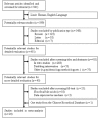Association between fecal bile acids and colorectal cancer: a meta-analysis of observational studies
- PMID: 18972600
- PMCID: PMC2615380
- DOI: 10.3349/ymj.2008.49.5.792
Association between fecal bile acids and colorectal cancer: a meta-analysis of observational studies
Abstract
Purpose: To provide a systematic review with meta-analysis for addressing the relationship between fecal bile acids (FBAs) and colorectal cancer.
Materials and methods: Electronic databases were searched for all observational studies that examined the relationship between FBAs and colorectal cancer or adenoma, and calculated weighted mean difference (WMD) and 95% confidence interval (CI). Publication bias was assessed with funnel plot.
Results: Twenty case-control or cohort studies were identified. All studies were pooled to assess the relationship between total FBAs and cancer/adenoma of the large bowel, however, no association was seen (WMD 0.61mg/g freeze-dried feces; 95% CI: -0.35-1.57). Significantly increased concentration of chenodeoxycholic acid (CDCA) was seen while pooling to assess the relationship between CDCA and cancer/adenoma of the large bowel (WMD 0.13 mg/g freeze-dried feces; 95% CI: 0.01-0.25), especially for colorectal cancer (WMD 0.28mg/g freeze-dried feces; 95% CI: 0.10-0.46). However, no significant differences in deoxycholic acid (DCA), lithocholic acid (LCA), and primary and secondary bile acids, were seen between patients with cancer and patients with matched controls regardless of fixed and random effects models.
Conclusion: CDCA might play a role in the etiology of colorectal cancer.
Figures








Similar articles
-
The effect of fecal bile acids on the incidence and risk-stratification of colorectal cancer: an updated systematic review and meta-analysis.Sci Rep. 2025 Jan 4;15(1):740. doi: 10.1038/s41598-024-84801-6. Sci Rep. 2025. PMID: 39753873 Free PMC article.
-
Kinetic analysis of bile acids in the feces of colorectal cancer patients by gas chromatography-mass spectrometry (GC-MS).Rinsho Byori. 2007 May;55(5):417-27. Rinsho Byori. 2007. PMID: 17593686
-
Asymptomatic colorectal neoplasia and fecal characteristics: a case-control study of subjects participating in the nottingham fecal occult blood screening trial.Dis Colon Rectum. 2002 Sep;45(9):1233-41. doi: 10.1097/01.DCR.0000027124.32274.F1. Dis Colon Rectum. 2002. PMID: 12352242
-
Analysis of bile acids in colon residual liquid or fecal material in patients with colorectal neoplasia and control subjects.J Gastroenterol. 1997 Jun;32(3):306-11. doi: 10.1007/BF02934485. J Gastroenterol. 1997. PMID: 9213242
-
Faecal steroids and colorectal carcinogenesis.Scand J Gastroenterol Suppl. 1997;222:76-82. doi: 10.1080/00365521.1997.11720725. Scand J Gastroenterol Suppl. 1997. PMID: 9145454 Review.
Cited by
-
Bacteroides, butyric acid and t10,c12-CLA changes in colorectal adenomatous polyp patients.Gut Pathog. 2021 Jan 12;13(1):1. doi: 10.1186/s13099-020-00395-0. Gut Pathog. 2021. PMID: 33436066 Free PMC article.
-
The effect of fecal bile acids on the incidence and risk-stratification of colorectal cancer: an updated systematic review and meta-analysis.Sci Rep. 2025 Jan 4;15(1):740. doi: 10.1038/s41598-024-84801-6. Sci Rep. 2025. PMID: 39753873 Free PMC article.
-
Galacto-oligosaccharides and Colorectal Cancer: Feeding our Intestinal Probiome.J Funct Foods. 2015 Jan;12:92-108. doi: 10.1016/j.jff.2014.10.029. J Funct Foods. 2015. PMID: 25584074 Free PMC article.
-
Role of bile acids in colon carcinogenesis.World J Clin Cases. 2018 Nov 6;6(13):577-588. doi: 10.12998/wjcc.v6.i13.577. World J Clin Cases. 2018. PMID: 30430113 Free PMC article. Review.
-
Elobixibat and its potential role in chronic idiopathic constipation.Therap Adv Gastroenterol. 2014 Jul;7(4):167-75. doi: 10.1177/1756283X14528269. Therap Adv Gastroenterol. 2014. PMID: 25057297 Free PMC article. Review.
References
-
- Hill MJ, Drasar BS, Williams RE, Meade TW, Cox AG, Simpson JE, et al. Faecal bile-acids and clostridia in patients with cancer of the large bowel. Lancet. 1975;1:535–539. - PubMed
-
- Bayerdörffer E, Mannes GA, Richter WO, Ochsenkühn T, Wiebecke B, Köpcke W, et al. Increased serum deoxycholic acid levels in men with colorectal adenomas. Gastroenterology. 1993;104:145–151. - PubMed
-
- Debruyne PR, Bruyneel EA, Karaguni IM, Li X, Flatau G, Müller O, et al. Bile acids stimulate invasion and haptotaxis in human colorectal cancer cells through activation of multiple oncogenic signaling pathways. Oncogene. 2002;21:6740–6750. - PubMed
-
- Fearon ER, Vogelstein B. A genetic model for colorectal tumorigenesis. Cell. 1990;61:759–767. - PubMed
-
- Reddy BS, Wynder EL. Metabolic epidemiology of colon cancer. Fecal bile acids and neutral sterols in colon cancer patients and patients with adenomatous polyps. Cancer. 1977;39:2533–2539. - PubMed
Publication types
MeSH terms
Substances
LinkOut - more resources
Full Text Sources
Medical
Research Materials

